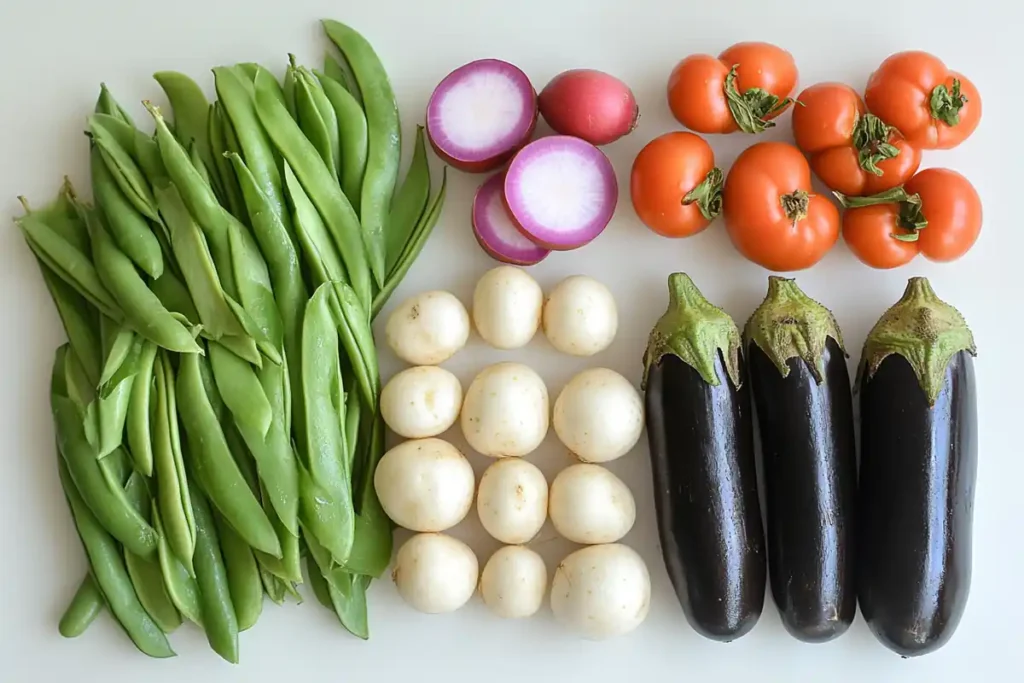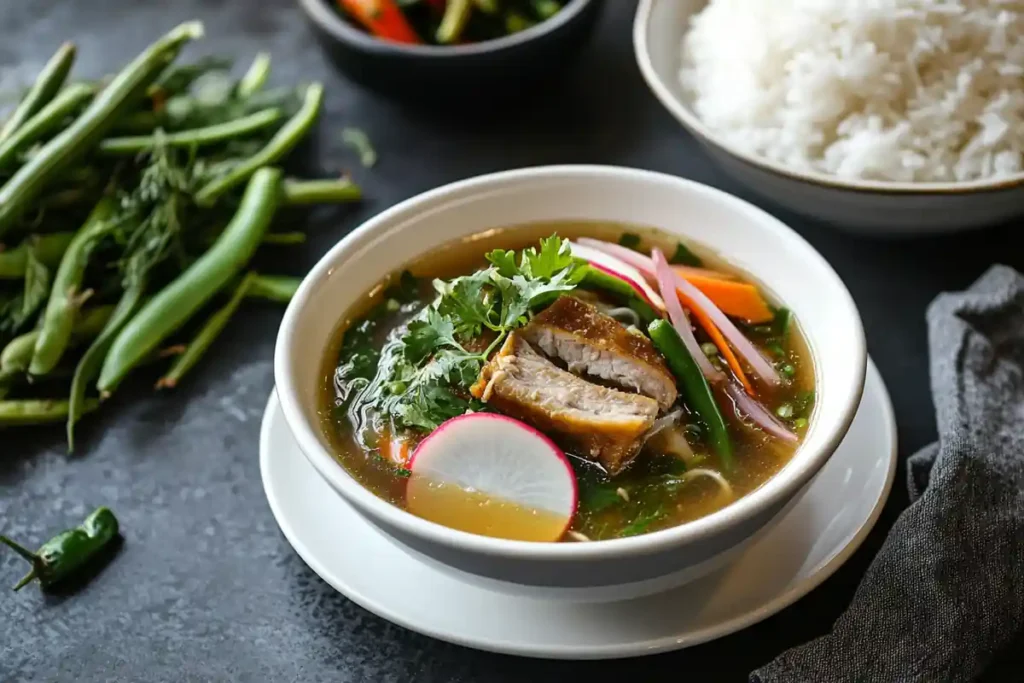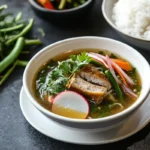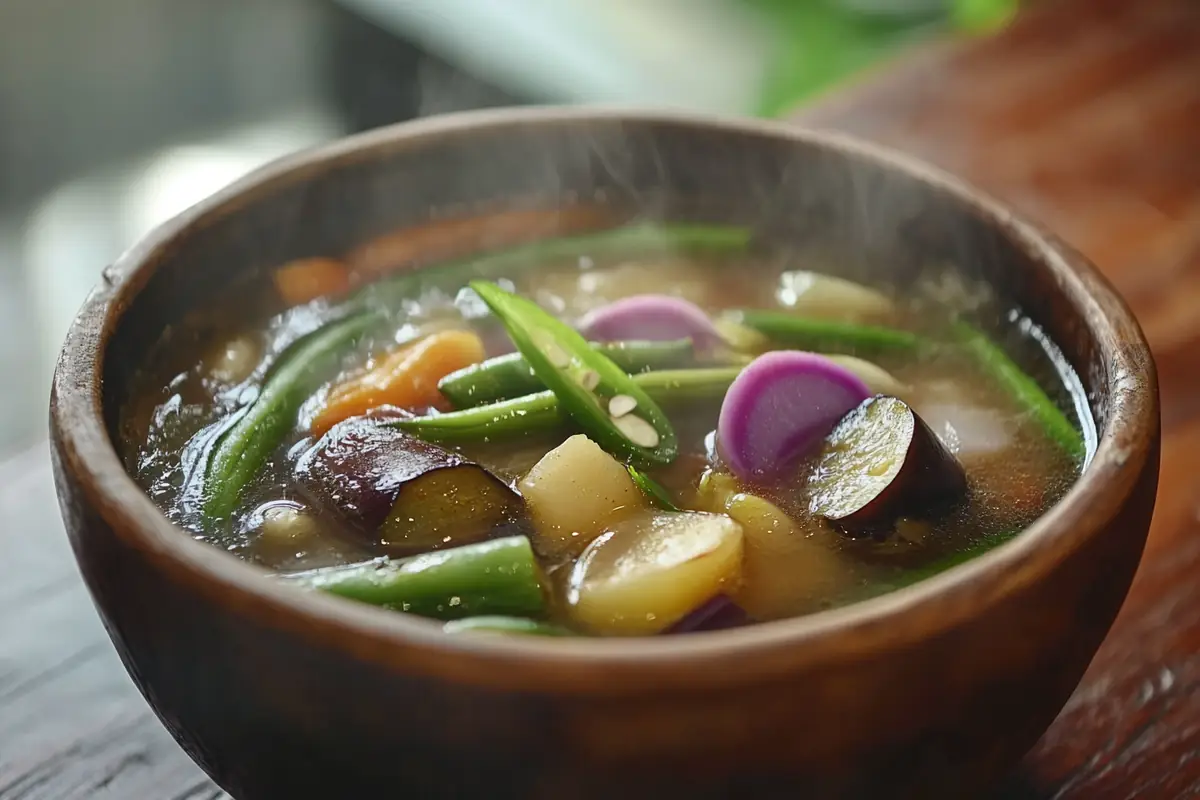Sinigang is more than just a meal; it’s a beloved staple of Filipino cuisine that has found its way into the hearts and homes of many. Known for its tangy, comforting broth, this dish celebrates the balance of flavors, textures, and cultural heritage. Whether you’re a seasoned cook or just starting to explore traditional Filipino recipes, this sinigang recipe is your ticket to culinary satisfaction. In this article, we’ll dive deep into the essentials of this dish, from its origins to step-by-step preparation and beyond.
What is Sinigang?
Sinigang: A Filipino Comfort Classic
Sinigang is a traditional Filipino sour soup, celebrated for its bold yet harmonious flavor profile. Its defining tang comes from tamarind, giving it a refreshing taste that pairs beautifully with a variety of vegetables and proteins. While it’s commonly enjoyed in the Philippines, this dish has gained international recognition for its simplicity and versatility.
Why Sinigang Stands Out
Unlike other soups, sinigang emphasizes the balance between sour, savory, and umami flavors. It’s often considered comfort food, evoking a sense of warmth and nostalgia for those who grew up eating it. Additionally, its adaptability makes it a favorite across regions, with every household having its unique twist on the recipe.
Sinigang Variations
From sinigang na hipon (shrimp) to fish-based sinigang, the base remains the same, but the choice of protein brings its own charm. Each version tells a story of the family or region that created it, making sinigang both a shared and personal experience.
By now, it’s clear that sinigang isn’t just food—it’s a reflection of Filipino identity, tradition, and creativity. Let’s dive deeper into its history and roots in the next section.
The Historical Roots of Sinigang
Tracing the Origins of Sinigang
The history of sinigang is as rich as its broth. While its exact origin remains unclear, culinary experts often link it to the Philippines’ agricultural roots. The abundance of sour fruits like tamarind, calamansi, and guava in the region heavily influenced its development. Historically, sinigang was a practical dish, as it allowed Filipinos to use fresh, locally available ingredients while creating a hearty, flavorful meal.
Sinigang in Filipino Culture
Sinigang is more than just sustenance—it’s a cultural icon. In Filipino households, it’s not uncommon to find families gathering around the table with a steaming pot of this sour soup at the center. It’s a dish that signifies unity, often served during celebrations, rainy days, or simply as a go-to comfort food after a long day.
Regional Influences on Sinigang
The versatility of sinigang means it’s adapted to the local flavors of various Philippine regions. For instance:
- Luzon-style Sinigang: Known for its tamarind-forward flavor, this version is the most iconic and widely recognized.
- Visayas and Mindanao Variations: Some regions incorporate batwan fruit or other local souring agents to achieve a similar tang.
- Coastal Sinigang: In coastal areas, seafood like shrimp and milkfish takes center stage, reflecting the region’s abundant marine life.
Ingredients for Sinigang

Essential Ingredients in a Sinigang Recipe
To create an authentic sinigang recipe, it’s important to use fresh and high-quality ingredients. These components work together to achieve the perfect harmony of sour, savory, and earthy flavors.
Tamarind: The Star Ingredient
The tangy flavor of sinigang comes primarily from tamarind. Traditionally, fresh tamarind pods are boiled and mashed to extract the juice. However, tamarind concentrate or powdered sinigang mix has become popular for convenience without compromising much on flavor.
Protein Options: Shrimp, or Fish
Sinigang is incredibly versatile when it comes to the protein choice:
- Shrimp: Light and flavorful, shrimp adds a coastal twist to the dish.
- Fish: Milkfish (bangus) or other firm white fish provides a delicate and refreshing take.
Vegetables that Complement Sinigang
Fresh vegetables are a key part of sinigang, adding texture and depth:
- String Beans: Provide a satisfying crunch and earthy taste.
- Radish: Absorbs the tangy broth, giving a subtle sweetness.
- Eggplant: Adds softness and complements the sourness.
- Tomatoes: Enhances the broth’s umami profile while adding a touch of natural sweetness.
Variations in Ingredients
In some regions or households, sinigang incorporates ingredients based on availability or preference. For instance:
- Green mango or calamansi is used as a souring agent in place of tamarind.
- Kangkong (water spinach): A popular alternative to string beans.
- Seafood sinigang: May include squid or mussels for added depth.
How to Prepare Sinigang

Step-by-Step Sinigang Recipe Guide
Creating a flavorful sinigang recipe isn’t just about the ingredients—it’s also about the process. Follow these steps to achieve a perfectly balanced and hearty dish every time.
Preparing the Ingredients
Start by organizing and prepping your ingredients:
- Clean and chop the vegetables. Slice the radish, eggplant, and string beans into bite-sized pieces for even cooking.
- Prepare the tamarind. If using fresh tamarind, boil the pods in water until soft, then mash and strain the pulp to extract its tangy juice. Alternatively, dilute tamarind concentrate or mix with water as instructed.
- Handle the protein. Rinse your chosen protein, shrimp, or fish—thoroughly under running water. Trim off excess fat or skin if desired.
Making the Sinigang Broth
- Add sliced tomatoes and onions to the pot early in the cooking process. They’ll help build the broth’s base flavors.
- Stir in the tamarind juice (or concentrate) and simmer for a few minutes. Adjust the amount to achieve your preferred level of sourness.
Adding Vegetables
- Add the vegetables in order of cooking time:
- Start with radish and eggplant, as they take longer to soften.
- Follow with string beans and kangkong (if using), cooking just until tender but still vibrant.
- Ensure the vegetables don’t overcook; they should retain some crunch to complement the tender protein.
Final Adjustments
- Season the broth with fish sauce or salt to taste. Add a small amount at first, then adjust gradually.
- For extra heat, toss in a few green chili peppers—whole or sliced.
- Stir gently and taste-test one last time. The broth should be a perfect balance of sourness, saltiness, and umami.
Tips and Tricks for the Perfect Sinigang
Common Mistakes to Avoid
Even seasoned cooks can encounter a few missteps when preparing sinigang. Here’s how to steer clear of them:
- Overcooking the Vegetables: Vegetables should be tender but not mushy. Adding them at the right time ensures they retain their texture and nutrients.
- Using Too Much Tamarind: While tanginess defines sinigang, an overpowering sourness can mask other flavors. Start with a smaller amount and adjust gradually.
- Not Skimming the Broth: Skimming impurities while simmering the protein results in a clearer, more appetizing broth.
Enhancing Your Sinigang Recipe
Want to take your sinigang recipe to the next level? Try these tips:
- Use Fresh Ingredients Whenever Possible: Fresh tamarind, vegetables, and protein make a noticeable difference in flavor.
- Experiment with Souring Agents: While tamarind is traditional, experimenting with green mango or kamias (bilimbi) can add a unique twist.
- Layer the Flavors: For a richer broth, sauté onions and tomatoes in a little oil before adding water. This step enhances the depth of the soup.
- Pair It Right: Sinigang is best enjoyed with steamed white rice, which balances its tangy flavor. A side of crispy fried fish or grilled meat also makes an excellent complement.
The Secret Ingredient: Love and Patience
Cooking sinigang isn’t just about following steps—it’s about understanding the flavors and adapting them to your taste. With a little patience and care, your sinigang will always be a crowd-pleaser.
Health Benefits of Sinigang
Why Sinigang is a Healthy Option
Sinigang is not only a flavorful dish but also one of the healthiest Filipino recipes. Its combination of fresh vegetables, lean protein, and a tangy broth makes it a nutrient-packed choice that suits various dietary preferences. Whether you’re seeking a balanced meal or a comfort dish, sinigang has you covered.
Nutritional Value of Key Ingredients
Tamarind: The Immune-Boosting Star
The tangy flavor of tamarind, the heart of any authentic sinigang recipe, offers more than just taste. It’s rich in:
- Vitamin C: Helps strengthen the immune system and protects against illnesses.
- Antioxidants: Combat free radicals, which contribute to aging and chronic diseases.
- Minerals: Like potassium and magnesium, which support healthy muscle and nerve function.
Vegetables: The Powerhouse of Nutrients
The array of vegetables in sinigang provides a diverse mix of essential vitamins and minerals:
- String Beans: High in fiber, aiding digestion and promoting gut health.
- Radish: Low in calories yet packed with antioxidants and potassium for heart health.
- Eggplant: Contains phytonutrients that boost brain health and reduce inflammation.
- Tomatoes: A source of lycopene, an antioxidant linked to heart health and cancer prevention.
Lean Protein: Building Blocks for the Body
Sinigang’s flexibility with protein options allows you to choose a source that suits your health goals:
- Shrimp: High in protein and omega-3 fatty acids, which promote brain and heart health.
- Fish: Rich in healthy fats and vitamin D, aiding bone health and reducing inflammation.
Low-Calorie, High-Satiety Meal
One of the standout benefits of sinigang is its low-calorie content. Despite being filling and satisfying, it’s free from heavy oils, creams, or fried components often found in other soups. The tangy broth, combined with nutrient-dense vegetables and protein, keeps you full without unnecessary calories, making it an excellent choice for weight management.
Hydrating and Easy to Digest
The broth in sinigang isn’t just flavorful—it’s hydrating and packed with electrolytes. This makes it a perfect meal for recovery, whether you’re dealing with illness, fatigue, or simply need a light yet nourishing dish. The gentle sourness also stimulates the appetite, making it easy on the stomach.
Heart-Healthy and Diabetes-Friendly
Sinigang can easily be modified to suit specific health needs:
- Opt for lean proteins like shrimp or fish to reduce saturated fat.
- Limit the use of salt by balancing the broth’s flavor with tamarind and natural umami from vegetables.
- Its high fiber content, particularly from string beans and radish, helps regulate blood sugar levels and supports heart health.
A Natural Detox for the Body
The ingredients in sinigang work together to cleanse and detoxify the body:
- Tamarind’s mild diuretic properties help flush out toxins.
- Vegetables rich in antioxidants and water content aid in improving kidney function and hydration.
Comparing Sinigang to Other Filipino Dishes
When placed alongside other popular Filipino dishes like kare-kare or lechon, sinigang shines as the healthier option. While kare-kare’s rich peanut sauce or lechon’s crispy skin might tempt your palate, sinigang provides a guilt-free indulgence with its light, broth-based preparation.inigang stands out for its lightness and nutritional profile. The sour broth is naturally hydrating and easy on the stomach, making it a preferred choice during hot weather or as a recovery meal when unwell.
Frequently Asked Questions About Sinigang Recipe

Can I use tamarind concentrate in sinigang?
Absolutely! Tamarind concentrate is a convenient substitute for fresh tamarind pods, especially when you’re short on time. Simply dilute the concentrate with water and adjust the quantity to achieve your preferred level of sourness. It offers the same tangy flavor without the effort of extracting juice from fresh tamarind.
Is Filipino sinigang healthy?
Yes, sinigang is a healthy dish! It’s loaded with fresh vegetables, lean protein, and a broth rich in antioxidants from tamarind. Unlike other hearty soups, sinigang doesn’t rely on heavy creams or excess fats, making it low in calories and ideal for a balanced diet.
What are the main ingredients of sinigang?
The key ingredients in a sinigang recipe include a souring agent (traditionally tamarind), protein such as shrimp, or fish, and vegetables like radish, string beans, and eggplant. Tomatoes and onions are also essential for building the base flavor of the broth.
What is sinigang called in English?
Sinigang is often referred to as “Filipino sour soup” in English. While the name doesn’t fully capture its complexity, it describes the dish’s defining tangy flavor derived from tamarind or other souring agents.
Why You Should Try This Sinigang Recipe
Sinigang isn’t just another dish—it’s a culinary experience that embodies the heart and soul of Filipino culture. From its rich history to its versatile ingredients and health benefits, this sinigang recipe is a testament to the beauty of simplicity and balance. Whether you’re savoring a warm bowl on a rainy day or serving it as a centerpiece for family gatherings, sinigang never fails to deliver comfort and joy.
The combination of tangy tamarind broth, tender protein, and fresh vegetables creates a harmonious symphony of flavors that appeals to both seasoned foodies and those new to Filipino cuisine. It’s a dish that’s adaptable, nutritious, and above all, delicious.
So why wait? Gather your ingredients, follow the steps outlined in this guide, and bring a taste of the Philippines to your table. Sinigang is more than just a meal—it’s an experience worth sharing with loved ones.
Print
Authentic Sinigang Recipe: A Filipino Comfort Classic
- Total Time: 55 minutes
- Yield: 6 servings 1x
Description
Sinigang is a traditional Filipino soup known for its tangy, savory, and hearty flavors. Made with a base of tamarind, it features tender meat or seafood, a medley of fresh vegetables, and a mouthwatering sour broth that is perfect for comforting meals. Sinigang is versatile, allowing variations with pork, beef, fish, or shrimp, depending on your preference.
Ingredients
For the Broth:
- 8 cups water or rice washing (hugas bigas)
- 2 medium tomatoes, quartered
- 1 large onion, quartered
- 1 packet tamarind soup mix (or 1 cup fresh tamarind pulp, adjusted to taste)
Protein:
- 1 ½ lbs pork belly, spareribs, or shrimp (choose your preferred protein)
Vegetables:
- 1 cup radish, sliced into rounds
- 1 cup eggplant, sliced
- 1 cup string beans (sitaw), cut into 2-inch pieces
- 2 cups water spinach (kangkong) or spinach leaves
- 2 small green chilies (siling pangsigang), optional
Seasoning:
- 2 tablespoons fish sauce (patis), to taste
- Salt, to taste
Instructions
- Prepare the Broth:
In a large pot, bring water or rice washing to a boil. Add the tomatoes and onion. Let them simmer for about 5 minutes to infuse the flavor into the broth. - Cook the Protein:
Add your chosen protein (pork or shrimp) to the pot. If using pork, let it simmer for 30–40 minutes or until tender. If using shrimp, add it later during the vegetable cooking stage to avoid overcooking. - Add Vegetables:
- Add the radish and eggplant to the pot and simmer for 5 minutes.
- Follow with string beans and cook for another 3–5 minutes.
- Flavor the Soup:
Stir in the tamarind mix or fresh tamarind pulp. Adjust the sourness to your liking. Season with fish sauce and salt, tasting as you go. - Finish with Greens:
Toss in the water spinach or spinach leaves and optional green chilies. Let them wilt for 1–2 minutes before turning off the heat. - Serve:
Ladle the sinigang into bowls and serve hot with steamed rice.
Notes
- Customization: Add or substitute vegetables like okra, taro (gabi), or green beans.
- Tamarind Alternatives: If fresh tamarind isn’t available, you can use tamarind concentrate or a blend of lemon juice and vinegar for a similar tangy effect.
- Prep Time: 15 minutes
- Cook Time: 40 minutes
- Category: Lunch
- Method: Boiling
- Cuisine: Filipino
Nutrition
- Calories: 320 kcal
- Sugar: 4 g
- Sodium: 680 mg
- Fat: 18 g
- Saturated Fat: 6 g
- Unsaturated Fat: 10 g
- Carbohydrates: 12 g
- Fiber: 3 g
- Protein: 28 g
- Cholesterol: 70 mg
Keywords: Sinigang, Filipino Soup, Tamarind Soup, Comfort Food

